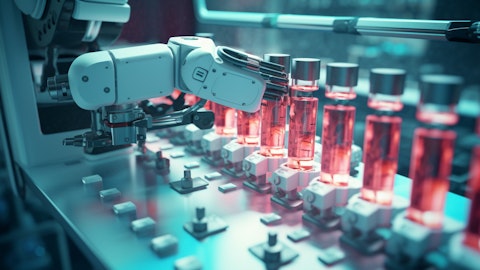Micron Technology, Inc. (NASDAQ:MU) Q2 2024 Earnings Call Transcript March 20, 2024
Micron Technology, Inc. beats earnings expectations. Reported EPS is $0.42, expectations were $-0.27. MU isn’t one of the 30 most popular stocks among hedge funds at the end of the third quarter (see the details here).
Operator: Thank you for standing by, and welcome to Micron’s Second Quarter 2024 Financial Call. At this time, all participants are in a listen-only mode. After the speakers’ presentation, there will be a question-and-answer session. [Operator Instructions] As a reminder, today’s program is being recorded. And now I’d like to introduce your host for today’s program, Satya Kumar, Corporate Vice President, Investor Relations and Treasurer. Please go ahead, sir.
Satya Kumar: Thank you, and welcome to Micron Technology’s Fiscal Second Quarter 2024 Financial Conference Call. On the call with me today are Sanjay Mehrotra, our President and CEO; and Mark Murphy, our CFO. Today’s call is being webcast from our Investor Relations site at investors.micron.com, including audio and slides. In addition, the press release detailing our quarterly results has been posted on the website, along with the prepared remarks for this call. Today’s discussion of financial results is being presented on a non-GAAP financial basis unless otherwise specified. A reconciliation of GAAP to non-GAAP financial measures can be found on our website. We encourage you to visit our website at micron.com throughout the quarter for the most current information on the company, including information on financial conferences that we may be attending.
You can also follow us on X at MicronTech. As a reminder, the matters we are discussing today include forward-looking statements regarding market demand and supply, market and pricing trends and drivers, our technology, product ramp plans and market position, our expected results and guidance, and other matters. These forward-looking statements are subject to risks and uncertainties that may cause actual results to differ materially from statements made today. We refer you to the documents we filed with the SEC, including our most recent Form 10-Q and upcoming 10-Q, for a discussion of risks that may affect our future results. Although we believe that the expectations reflected in the forward-looking statements are reasonable, we cannot guarantee future results, levels of activity, performance, or achievements.
We are under no duty to update any of the forward-looking statements to conform these statements to actual results. I will now turn the call over to Sanjay.
Sanjay Mehrotra: Thank you, Satya. Good afternoon, everyone. I am pleased to report that Micron delivered fiscal Q2 revenue, gross margin, and EPS well above the high end of guidance. Micron has returned to profitability and delivered positive operating margin a quarter ahead of expectation. I would like to thank all our Micron global team members for their dedication and excellent execution that made this result possible. Micron drove robust price increases as the supply-demand balance tightened. This improvement in market conditions was due to a confluence of factors, including strong AI server demand, a healthier demand environment in most end markets, and supply reductions across the industry. AI server demand is driving rapid growth in HBM, DDR5, and data center SSDs, which is tightening leading-edge supply availability for DRAM and NAND.
This is resulting in a positive ripple effect on pricing across all memory and storage end markets. We expect DRAM and NAND pricing levels to increase further throughout calendar year 2024 and expect record revenue and much improved profitability now in fiscal year 2025. Micron is at the forefront of ramping the industry’s most advanced technology nodes in both DRAM and NAND. Reinforcing our leadership position, over three-quarters of our DRAM bits are now on leading-edge 1-alpha and 1-beta nodes, and over 90% of our NAND bits are on 176-layer and 232-layer nodes. We expect fiscal 2024 front-end cost reductions, excluding the impact of HBM, to track in line with our long-term expectations of mid to high single digits in DRAM and low teens in NAND, supported by the continued volume ramp of 1-beta DRAM and 232-layer NAND.
We continue to mature our production capability with extreme ultraviolet lithography and have achieved equivalent yield and quality on our 1-alpha as well as 1-beta nodes between EUV and non-EUV flows. We have begun 1-gamma DRAM pilot production using EUV and are on track for volume production in calendar 2025. The development of our next-generation NAND node is on track, with volume production planned for calendar 2025. We expect to maintain our technology leadership in NAND. Now turning to our end markets. Inventories for memory and storage have improved significantly in the data center, and we continue to expect normalization in the first half of calendar 2024. In PC and smartphone, there were some strategic purchases in calendar Q4 in anticipation of a return to unit growth.
Inventories remain near normal levels for auto, industrial, and other markets. We are in the very early innings of a multiyear growth phase driven by AI as this disruptive technology will transform every aspect of business and society. The race is on to create artificial general intelligence, or AGI, which will require ever-increasing model sizes with trillions of parameters. On the other end of the spectrum, there is considerable progress being made on improving AI models, so that they can run on edge devices, like PCs and smartphones, and create new and compelling capabilities. As AI training workloads remain a driver of technology and innovation, inference growth is also rapidly accelerating. Memory and storage technologies are key enablers of AI in both training and inference workloads, and Micron is well-positioned to capitalize on these trends in both the data center and the edge.
We view Micron as one of the biggest beneficiaries in the semiconductor industry of this multiyear growth opportunity driven by AI. In data center, total industry server unit shipments are expected to grow mid to high single digits in calendar 2024, driven by strong growth for AI servers and a return to modest growth for traditional servers. Micron is well positioned with our portfolio of HBM, D5, LP5, high-capacity DIMM, CXL, and data center SSD products. Delivering improved memory bandwidth, power consumption, and overall performance is critical to enable cost-efficient scaling of AI workloads inside modern GPU or ASIC-accelerated AI servers. Our customers are driving an aggressive AI roadmap on their GPU and ASIC-based server platforms that require significantly higher content and higher-performance memory and storage solutions.
For example, earlier this week, Nvidia announced its next-generation Blackwell GPU architecture-based AI systems, which provides a 33% increase in the HBM3E content, continuing a trend of steadily increasing HBM content per GPU. Micron’s industry-leading high-bandwidth memory HBM3E solution provides more than 20 times the memory bandwidth compared to standard D5-based DIMM server module. We are executing well on our HBM product ramp plans and have made significant progress in ramping our capacity, yields, and quality. We commenced volume production and recognized our first revenue from HBM3E in fiscal Q2 and now have begun high-volume shipments of our HBM3E product. Customers continue to give strong feedback that our HBM3E solution has a 30% lower power consumption compared to competitors’ solutions.
This benefit is contributing to strong demand. Our HBM3E product will be a part of Nvidia’s H200 Tensor Core GPUs, and we are making progress on additional platform qualifications with multiple customers. We are on track to generate several hundred million dollars of revenue from HBM in fiscal 2024 and expect HBM revenues to be accretive to our DRAM and overall gross margins starting in the fiscal third quarter. Our HBM is sold out for calendar 2024, and the overwhelming majority of our 2025 supply has already been allocated. We continue to expect HBM bit share equivalent to our overall DRAM bit share some time in calendar 2025. Earlier this month, we sampled our 12-high HBM3E product, which provides 50% increased capacity of DRAM per cube to 36 gigabyte.
This increase in capacity allows our customers to pack more memory per GPU, enabling more powerful AI training and inference solutions. We expect 12-high HBM3E will start ramping in high-volume production and increase in mix throughout 2025. We have a robust roadmap and we are confident we will maintain our technology leadership with HBM4, the next generation of HBM, which will provide further performance and capacity enhancements compared to HBM3E. We are making strong progress on our suite of high-capacity server DIMM products. During the quarter, we completed validation of the industry’s first mono-die-based 128 gigabyte server DRAM module. This new product provides the industry’s highest-bandwidth D5 capability, with greater than 20% better energy efficiency and over 15% improved latency performance compared to competitors’ 3D TSV-based solutions.
We see strong customer pull and expect a robust volume ramp for our 128 gigabyte product, with several hundred million dollars of revenue in the second half of fiscal 2024. Additionally, we also started sampling our 256 gigabyte MCRDIMM module, which further enhances performance and increases DRAM content per server. We achieved record revenue share in the data center SSD market in calendar 2023. During the quarter, we grew our revenue by over 50% sequentially for our 232-layer-based 6500 30 terabytes SSDs, which offer best-in-class performance, reliability, and endurance for AI data lake applications. In PC, after two years of double-digit declines, unit volumes are expected to grow modestly in the low single-digit range for calendar 2024.
We are encouraged by the strong ecosystem momentum to develop next-generation AI PCs, which feature high-performance Neural Processing Unit chipsets and 40% to 80% more DRAM content versus today’s average PCs. We expect next-generation AI PC units to grow and become a meaningful portion of total PC units in calendar 2025. At CES, the consumer electronics show in Las Vegas, Micron launched the industry’s first low-power compression-attached memory module, or LPCAMM2, for PC applications. LPCAMM2 brings a modular form factor, with a maximum capacity point of 64 gigabyte for PC module and 128 gigabyte for server module, along with a number of benefits such as higher bandwidth, lower power, and smaller form factor. During the quarter, we launched our 232-layer-based Crucial T705 Gen 5 consumer SSD, which won several editor choice awards and was recognized by a leading publisher as the fastest M.2 SSD ever.
We increased our client SSD QLC bit shipments to record levels, with QLC representing nearly two-thirds of our client SSD shipments, firmly establishing Micron as the leader in client QLC SSDs. Turning to mobile. Smartphone unit volumes in calendar 2024 remain on track to grow low to mid-single digits. Smartphones offer tremendous potential for personalized AI capabilities that offer greater security and responsiveness when executed on device. Enabling these on-device AI capabilities is driving increased memory and storage capacity needs and increasing demand for new value-add solutions. For example, we expect AI phones to carry 50% to 100% greater DRAM content compared to non-AI flagship phones today. Micron’s leading mobile solutions provide the critical high performance and power efficiency needed to unlock an unprecedented level of AI capability.
In DRAM, we are now sampling our second-generation, 1-beta LPDRAM LP5X product, which delivers the industry’s highest performance at improved power for flagship smartphones. And in NAND, we announced our second generation of 232-layer NAND UFS 4.0 devices, featuring the industry’s smallest package and breakthrough features that enable greater reliability and significantly higher real-world performance for complex workloads. Our mobile DRAM and NAND solutions are now widely adopted in industry-leading flagship smartphones, with two examples being Samsung’s Galaxy S24 and the Honor Magic 6 Pro announced this year. The Samsung Galaxy S24 can provide two-way, real-time voice and text translations during live phone calls. The Honor Magic 6 Pro features the Magic LM, a seven-billion parameter large language model, which can intelligently understand a user’s intent based on language, image, eye movement, and gestures and proactively offer services to enhance and simplify the user experience.
Turning to auto and industrial. The automotive sector continues to experience robust demand for memory and storage as non-memory semiconductor supply constraints have eased and as new vehicle platforms are launched. In the past quarter, we experienced strong growth with partners who are driving the most advanced capabilities within the automobile’s increasingly intelligent and connected digital cockpits. In addition, adoption of Level 2+ ADAS capabilities continues to gain momentum, further expanding content per vehicle. The industrial market fundamentals for memory are also healthy, with improving distributor inventory, book-to-bill, and demand visibility improvements, as well as pricing benefits from the tight supply for products, especially those built on leading-edge nodes.
Now, turning to our market outlook. Calendar 2023 DRAM bit demand growth was in the low double-digit percentage range, and NAND bit demand growth was in the low-20s percentage range, both a few percentage points higher than previous expectations. We forecast calendar 2024 bit demand growth for the industry to be near the long-term CAGR for DRAM and around the mid-teens for NAND. Given the higher baseline of 2023 demand, these expectations of 2024 bit growth have driven an increase in the absolute level of 2024 bit demand in our model for DRAM and NAND versus our prior expectations. The industry supply-demand balance is tight for DRAM and NAND, and our outlook for pricing has increased for calendar 2024. Over the medium term, we expect bit demand growth CAGRs of mid-teens in DRAM and low-20s percentage range in NAND.

Turning to supply. The supply outlook remains roughly the same as last quarter. We expect calendar 2024 industry supply to be below demand for both DRAM and NAND. Micron’s bit supply growth in fiscal 2024 remains below our demand growth for both DRAM and NAND, and we expect to decrease our days of inventory in fiscal year 2024. Micron’s fiscal 2024 CapEx plan remains unchanged at a range between $7.5 billion and $8.0 billion. We continue to project our WFE spending will be down year-on-year in fiscal 2024. Micron’s capital-efficient approach to reuse equipment from older nodes to support conversions to leading-edge nodes has resulted in a material structural reduction of our DRAM and NAND wafer capacities. We are now fully utilized on our high-volume manufacturing nodes and are maximizing output against the structurally lowered capacity.
We believe this approach to node migration and consequent wafer capacity reduction is an industry-wide phenomenon. We project to end fiscal 2024 with low double-digit percentage less wafer capacity in both DRAM and NAND than our peak levels in fiscal 2022. Significant supply reductions across the industry have enabled the pricing recovery that is now underway. Although our financial performance has improved, our current profitability levels are still well below our long-term targets, and significantly improved profitability is required to support the R&D and CapEx investments needed for long-term innovation and supply growth. Micron will continue to exercise supply and CapEx discipline and focus on restoring improved profitability while maintaining our bit market share for DRAM and NAND.
As discussed previously, the ramp of HBM production will constrain supply growth in non-HBM products. Industrywide, HBM3E consumes approximately three times the wafer supply as D5 to produce a given number of bits in the same technology node. With increased performance and packaging complexity, across the industry, we expect the trade ratio for HBM4 to be even higher than the trade ratio for HBM3E. We anticipate strong HBM demand due to AI, combined with increasing silicon intensity of the HBM roadmap, to contribute to tight supply conditions for DRAM across all the end markets. Finally, as we consider these demand and technology trends, we are carefully planning our global fab and assembly/test capacity requirements to ensure a diversified and cost-competitive manufacturing footprint.
Announced projects in China, India, and Japan are proceeding as planned. On potential U.S. expansion plans, we have assumed CHIPS grants in our CapEx plans for fiscal 2024. Our planned Idaho and New York projects require Micron to receive the combination of sufficient CHIPS grants, investment tax credits, and local incentives to address the cost difference compared to overseas expansion. I will now turn it over to Mark for our financial results and outlook.
Mark Murphy: Thanks, Sanjay, and good afternoon, everyone. Micron delivered strong results in fiscal Q2 with revenue, gross margin, and EPS well above the high end of the guidance ranges provided in our last earnings call. Much improved market conditions, along with the team’s excellent execution on pricing, products, and operations, drove the strong financial results. Total fiscal Q2 revenue was $5.8 billion, up 23% sequentially and up 58% year-over-year. Fiscal Q2 DRAM revenue was approximately $4.2 billion, representing 71% of total revenue. DRAM revenue increased 21% sequentially, with bit shipments increasing by a low single-digit percentage and prices increasing by high teens. Fiscal Q2 NAND revenue was approximately $1.6 billion, representing 27% of Micron’s total revenue.
NAND revenue increased 27% sequentially, with bit shipments decreasing by a low single-digit percentage and prices increasing by over 30%. Now turning to revenue by business unit. Compute and Networking Business Unit revenue was $2.2 billion, up 26% sequentially. Data center revenue grew robustly, and cloud more than doubled sequentially. Revenue for the Mobile Business Unit was $1.6 billion, up 24% sequentially, as an expected decline in volume was more than offset by improved pricing. Embedded Business Unit revenue was $1.1 billion, up 7% sequentially on solid demand for leading-edge products in the industrial market. Revenue for the Storage Business Unit was $905 million, up 39% sequentially with strong double-digit growth across all end markets.
Datacenter SSD revenue more than doubled from a year ago, driven by share gains for Micron’s products. The consolidated gross margin for fiscal Q2 was 20%, up 19 percentage points sequentially driven by higher pricing. Fiscal Q2 gross margins benefited from $382 million associated with selling the remainder of previously written-down inventories. In the second fiscal quarter, underutilization charges were modest and related to our legacy manufacturing capacity. We expect to sustain these lower levels of underutilization charges moving forward. Operating expenses in fiscal Q2 were $959 million, down $33 million quarter-over-quarter and in line with our guidance range. OpEx was modestly above the midpoint of our guidance range, as variable compensation expense was higher on an improved fiscal 2024 outlook.
We generated operating income of $204 million in fiscal Q2, resulting in an operating margin of 4% and turning positive a quarter earlier than originally forecasted. We recognized a net benefit for income taxes in fiscal Q2 of $294 million. We had previously guided that we would recognize tax expense of $45 million based on expected quarterly results for fiscal Q2. With our improved fiscal 2024 outlook, we can now estimate a more reliable annual effective tax rate and have reverted to a global annual effective tax rate method. The second fiscal quarter tax benefit arises from applying this estimated annual effective tax rate to our year-to-date results. Non-GAAP diluted earnings per share in fiscal Q2 was $0.42, compared to a loss per share of $0.95 in the prior quarter and a loss per share of $1.91 in the year-ago quarter.
Fiscal Q2 EPS benefited from the aforementioned favorable income tax effect of approximately $0.34 per share. Turning to cash flows and capital spending, our operating cash flows were approximately $1.2 billion in fiscal Q2, representing 21% of revenue. Capital expenditures were $1.2 billion during the quarter, and free cash flow was near breakeven. Our fiscal Q2 ending inventory was $8.4 billion or 160 days, roughly in line with the prior quarter. Finished goods were down in the quarter. Our leading-edge supply both for DRAM and NAND is very tight. We expect to reduce inventory levels and excluding strategic inventory stock, be within a few weeks of our 120 days target by the end of fiscal 2024. We project DIO improvements to continue into fiscal year 2025.
On the balance sheet, we held $9.7 billion of cash and investments at quarter end and maintained $12.2 billion of liquidity when including our untapped credit facility. During fiscal Q2, we refinanced approximately $1 billion of existing debt, extending our debt maturities and lowering our near-term borrowing costs. We ended the quarter with $13.7 billion in total debt, low net leverage, and a weighted average maturity on our debt of 2031. Now turning to our outlook for the fiscal third quarter. Fiscal Q3 bit shipments are expected to be down modestly for DRAM and up somewhat for NAND, compared to fiscal Q2 levels. While demand continues to improve, supply is constrained, especially at the leading edge. We expect DIO to improve sequentially in fiscal Q3.
Note that fiscal Q2 gross margins had the benefit from previously written-down inventories, which have cleared completely in fiscal Q2. Despite this benefit in fiscal Q2, we expect solid sequential improvement in fiscal Q3 gross margins due to robust price increases across both DRAM and NAND. We forecast operating expenses to increase by approximately $30 million in the fiscal third quarter, driven by R&D expenses. For the fiscal year, we now project OpEx to be approximately $4 billion. Having delivered operating profit in fiscal Q2 ahead of prior expectations, we forecast continued improvement in operating income through the remainder of the year. Based on an improved taxable income outlook, our tax forecast for fiscal year 2024 has increased from a prior projection of over $300 million to approximately $400 million.
In fiscal 2025, we expect our annual effective tax rate to be in the mid-teens percentage range. We plan fiscal Q3 capital expenditures to be higher than in the second quarter. Our full-year fiscal 2024 CapEx plan is unchanged at a range between $7.5 billion and $8 billion. We now expect to generate positive free cash flow in fiscal Q3 and Q4. With all these factors in mind, our non-GAAP guidance for fiscal Q3 is as follows. We expect revenue to be $6.6 billion, plus or minus $200 million; gross margin to be in the range of 26.5%, plus or minus 150 basis points; and operating expenses to be approximately $990 million, plus or minus $15 million. We expect tax expenses of approximately $240 million. Based on a share count of approximately 1.1 billion shares, we expect earnings per share of $0.45, plus or minus $0.07.
In closing, with a significantly improved supply demand balance in the industry coupled with excellent execution, Micron is driving a strong inflection in pricing and a richer mix of high-value solutions. We remain disciplined with our investments and supply growth and focused on driving efficiency across the company. We expect positive free cash flow for the second half of fiscal 2024 and project record revenue in fiscal 2025. I will now turn it back over to Sanjay.
Sanjay Mehrotra: Thank you, Mark. [Technical Difficulty]
Operator: Ladies and gentlemen, your program will resume momentarily. Once again, please standby, your program will resume momentarily. Thank you for your patience and please continue to hold.
Sanjay Mehrotra: Hi, can you hear us?
Operator: Yes. Yes. Welcome back. Ladies and gentlemen, we will resume.
Sanjay Mehrotra: Yes, so we apologize for the technical difficulty here. But, operator if you can go ahead and start the Q&A section, please?
See also 12 Best Bond ETFs To Buy and 15 Best Blockchain and Bitcoin ETFs.
Q&A Session
Follow Micron Technology Inc (NASDAQ:MU)
Follow Micron Technology Inc (NASDAQ:MU)
Operator: Certainly. One moment for our first question. And our first question comes from the line of Toshiya Hari from Goldman Sachs. Your question, please.
Toshiya Hari: Hi, can you guys hear me okay?
Operator: Yes.
Mark Murphy: Yes, we can.
Toshiya Hari: Okay, great. Thank you for taking the question. Sanjay on HBM, you mentioned that you continue to expect your market position in ’25 or at some point in ’25 to be similar, to be in line with your overall position in DRAM. Given your revenue outlook for ’24, that seems to imply, I don’t know quadrupling or quintupling of your business in HBM year-to-year. I guess part one, am I thinking about the trajectory accurately? And then part two, how should we — what does that mean for your CapEx over the next 12, 18 months, and more importantly, your wafer capacity? You mentioned fiscal year ’24, you’re down low-double-digits. Is your wafer capacity likely to be down again in fiscal ’25? Thank you.
Sanjay Mehrotra: So HBM3E, first of all, it’s a great product. As I mentioned well received by our customers, high-performance, and 30% lower-power than any other product that’s out there. So of course it has strong demand and as we have highlighted, we are sold out for our calendar year ’24 supply and calendar year ’25 supply is also mostly vast majority is already allocated. We are — we have just begun production shipments, and these will continue to increase through the course of calendar year ’24, as well as continue to increase through calendar year ’25. We are continuing to work on increasing our capacity and making good progress with respect to capacity as well as overall yield and quality. So certainly, in calendar year ’25 versus calendar year ’24, given that we are just starting our production here now, will certainly be a significant growth over our calendar year ’24 numbers.
And you can look at it the same way for fiscal ’24 versus ’25, so it will be definitely a significant increase with us, achieving our shares in HBM, in line with our industry share, sometime in calendar ’25. I’m not in a position to spell it out exactly for you in terms of what is the volume increase, but certainly HBM with our strong product position, it will be a strong driver of revenue growth, fiscal year ’24 — fiscal year ’25 or fiscal year ’24. Regarding the wafer capacity by end of this fiscal year, we have said low double-digit structural reduction in capacity. And of course, we will be managing this capacity in fiscal year ’24, keeping in mind our focus on supply-demand discipline, I was staying extremely disciplined with respect to supply growth, staying extremely disciplined with respect to our HBM share as well.
And advantaging our technology transitions, as we go through the year. And our CapEx in ’25 — well, in fiscal ’25 will be higher than fiscal ’24. WFE will be higher as well. And of course, construction CapEx related to the Greenfield that is required for the second half of the decade will contribute to some of the CapEx increase in fiscal ’25. But some of those details we’ll provide you as we get closer to fiscal year ’25. So, most important thing is that we will manage our wafer capacity technology transitions to really maintain our bit share, that is part of our strategy to have stable bit share even with increasing penetration of HBM. And again, just keep in mind that our overall framework of our CapEx being 35% of our revenue across the cycles still applies.
Toshiya Hari: Thank you for all the details.
Operator: Thank you. One moment for our next question. And our next question comes from the line of Aaron Rakers from Wells Fargo. Your question, please.
Aaron Rakers: Yes. Thank you very much for taking the question. I guess two real quick ones. One I just wanted to understand or maybe appreciate the context of the accretive nature of HBM3. I know in the prepared remarks, I think are — in the slide deck it notes that you’ll be accretive gross margin from HBM in the current quarter. And then I know you talked a little bit about PCs and smartphones. I’m curious of — what you’re seeing in terms of traditional server demand and whether or not your forecast assumes any improvement of shipments in that end-market. Thank you.
Sanjay Mehrotra: So with respect to the accretive nature of HBM, look, HBM carries a higher cost, but it also carries a significantly higher pricing because it brings such great value in the applications in terms of its performance and power. And we are executing well. Our yield ramp is going well as well according to plan. And therefore, we are pleased that in this quarter when we have begun our production shipments, we will be having it accretive to our gross margins in the quarter. And of course, this momentum will continue to build in the quarters ahead. And regarding the second part of your question on traditional server demand, so yes, we do see that in calendar ’25, traditional server demand will grow modestly. And of course, it’s coming after a significant decline in server unit sales in calendar ’23.
We are very pleased to see the increasing momentum of content growth in the traditional server demand. But also AI server units are going up and AI — we have said overall server units going up in mid- to high-single-digits range with AI server driving a higher growth percentage year-over-year and traditional servers being modest. And I may have said ’25 here, I just want to clarify that I’m talking about 2024 here. So when I’m talking about modest server unit growth, it’s referring to 2024 versus 2023.
Aaron Rakers: Thank you.
Sanjay Mehrotra: And we are actually seeing strong demand for both our DRAM products and NAND products in server and actually we are shifting some of our portfolio toward these higher mix solutions. HBM being one of them. High-density DIMMs being another one that’s in strong demand for server applications and then data center SSDs. All of this is — we are seeing a healthy demand drivers. And just remember we had said that for memory and storage, customer inventories in data center market would be largely normalized in first half of ’24. And we are seeing the market play out just as we had predicted several quarters ago.





